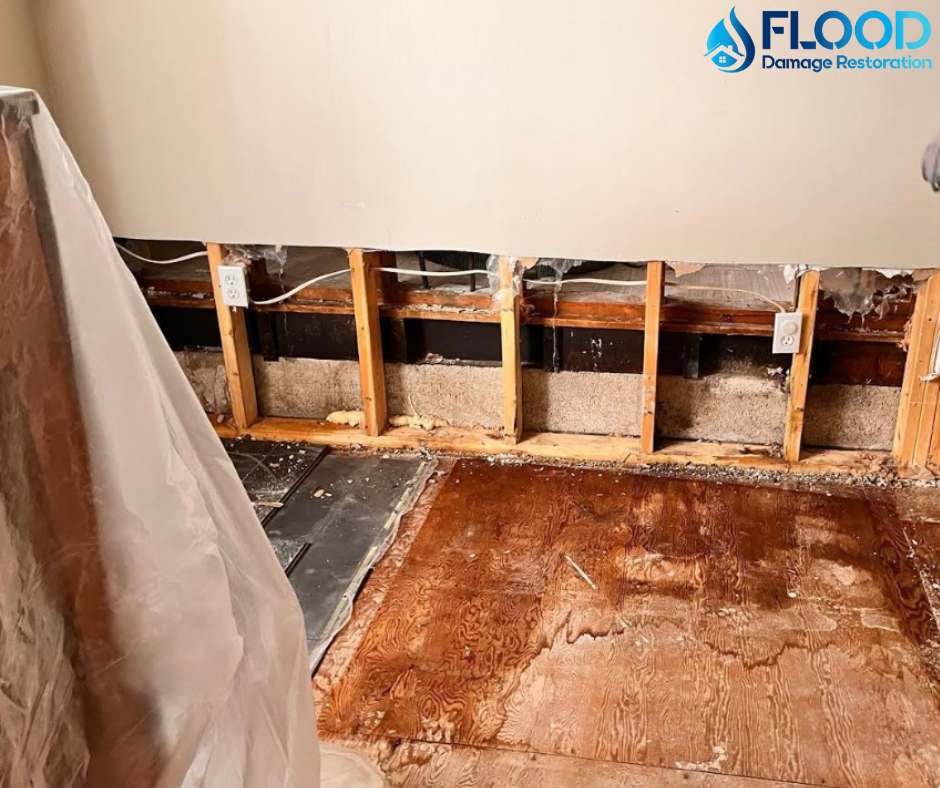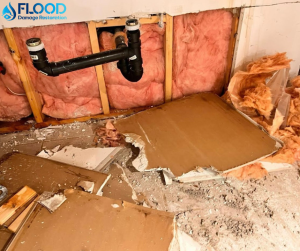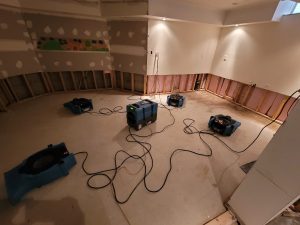
- Heavy Rainfall and Waterproofing Overload
- In Toronto, excessive rain can overwhelm basement waterproofing systems, leading to water seepage through foundation cracks. Ensuring your basement waterproofing is up to par is crucial in these conditions.
- Improper Land Sloping
- Properties with lawns sloping towards the house funnel rainwater directly to the foundation, increasing the risk of basement flooding.
- Sewer Back-Up Issues
- Basements can flood due to damaged or clogged sewer tie-in lines, causing dirty water to flow backward from household drains. This is a clear sign of sewer backup issues.
- Sump Pump Failures
- Sump pump malfunctions, including failure, issues, and not-working scenarios, are common causes of severe basement water damage, particularly in areas built on marshy land. Knowing sump pump troubleshooting, including what to do if your sump pump fails or isn’t turning on, is essential in preventing a sump pump-flooded basement.
- Plumbing System Leaks
- Leaky pipes within basement plumbing can lead to significant flooding, given the volume of water they transport.
- Foundation Integrity Problems
- Water infiltrates basements through cracks and leaks in the building’s foundation, often exacerbated by environmental factors. Addressing foundation repair early can mitigate these risks.
- Inadequate Drainage Systems
- Faulty or inadequate drainage can cause extensive basement flooding, especially during heavy rainfall or snowmelt periods.
- Overland Water Flow
- During intense rain or melting snow, water can enter properties through any vulnerabilities in the foundation, basement walls, or improperly sealed basement windows and doors.
- Drainage System Failures
- Issues such as overflowing eavestroughs, blocked downspouts, or failed weeping tile systems contribute to water accumulation around and under the foundation.
- Root Intrusion in Sewer Lines
- Tree roots can invade sewer lines through existing cracks or weak joints, leading to blockages and subsequent sewer backups into the basement.
Immediate Steps to Mitigate Damage
Immediate Steps to Mitigate Damage
Quick action is crucial when flooding strikes your basement to minimize damage and ensure safety. Here are immediate steps to take:
1. Shut Off Electrical Power
- Contact Toronto Hydro to shut off power to prevent electrical accidents, especially if water has reached electrical outlets or appliances.
2. Stop Using Plumbing
- If you suspect sewer backup, cease using toilets and sinks to avoid worsening the situation.
3. Report to City Authorities
- Call 311 or use the online service request page to alert city staff. They will inspect the flooding and attempt to identify the source.
4. Prioritize Health and Safety
- Be aware of potential health risks from waterborne diseases and chemicals in the water. Avoid contact with contaminated water, wear protective gear, and ensure that children and pets stay clear of the area.
5. Assess and Mitigate Electrical Risks
- Have a licensed electrical contractor check for potential hazards before re-entering the basement.
6. Professional Cleanup
- Consider hiring professionals experienced in dealing with sewage-contaminated environments for cleaning and restoration.
7. Document for Insurance
- Reporting the incident to 311 helps with insurance claims and may assist in an investigation to prevent future incidents.
8. Remove Water
- Use sump pumps, wet vacs, or manual methods to remove standing water as swiftly as possible.
9. Dry Out the Area
- Employ fans and dehumidifiers to dry the area once water is removed, and dispose of water-damaged items like carpets and furniture.
10. Clean and Disinfect
- Thoroughly clean all surfaces with appropriate cleaners to prevent mold and mildew buildup.
Following these steps can help you effectively manage a basement flooding, reducing damage and safeguarding your home and health.
Legal and Insurance Considerations Following a Flood
Water damage is a significant issue in Canada, with over half of all home insurance payouts stemming from such incidents. The frequency and severity of claims have notably increased due to more common storms and the high cost of items stored in basements. For homeowners facing basement floods, understanding insurance coverage is crucial. Most policies cover damages caused by sudden and unforeseeable events, yet many exclude issues like leaky foundations or sump pump failures unless additional coverage is purchased for sump pump problems.
Understanding Your Insurance Policy
- Sudden or Accidental Water Damage: This is typically covered under standard home insurance policies, including damages from indoor plumbing, heating, or air conditioning malfunctions.
- Sewer Backup Coverage: Sewer backup damage generally requires additional protection, which must be explicitly included in your policy to address sewer backup issues effectively.
- Overland Flooding and Natural Disasters: Standard policies do not usually cover damages from overland flooding or natural disasters like storm surges, with specific flood coverage needing to be purchased separately.
Legal Assistance and Claims Process
- Consultation with Legal ExpertsIt’s advisable to consult with a legal team for a free consultation to discuss the specifics of your flood incident and explore your claims and options.
- Dealing with Insurance CompaniesIf there are disputes or concerns about how your insurance company handles your claim, an insurance claim lawyer can be instrumental. They assist in understanding policy details, navigating the claims process, and negotiating with insurers.
- LitigationIn cases where insurance claims are unfairly denied or underpaid, legal action might be necessary. Lawyers can uphold your rights and pursue litigation if required.
Assessing Whether to File a Claim
Consider the cost of the damage relative to your deductible. If the damage cost is not substantially higher than the deductible, filing a claim may not be economically beneficial. Always ensure comprehensive coverage that aligns with your needs by reviewing your policy details regularly and after significant life or property changes.

Long-Term Prevention Strategies
Remove Debris and Manage Water Flow
- Storm Drain Maintenance: Regularly clear storm drains to ensure they can effectively handle water during heavy rainfall.
- Foundation Water Management: Extend downspouts at least 10 feet away from your foundation to direct stormwater away and prevent accumulation near the base of your home, effectively acting as a discharge line.
Enhance Structural Integrity
- Seal Potential Entry Points: To maintain a watertight barrier, use hydraulic cement or caulk to repair cracks in your foundation and windows.
- Window Well Protection: Install covers over window wells to prevent water accumulation.
Water Management Systems
- Sump Pump Installation and Maintenance: Install a sump pump to actively remove water from your basement. Regular maintenance includes checking the float switch and cleaning the sump pit to avoid clogs.
- Back-Up Systems: Equip your home with a backup sump pump to ensure functionality during power outages.
Landscape and Exterior Adjustments
- Proper Landscaping involves: Positioning trees and shrubs at least 10 feet away from your foundation and ensuring properly graded mulch is at least six inches from your home’s walls.
- Lawn and Gutter Upkeep: Properly grade your lawn to facilitate water flow away from your home. Clean gutters and downspouts regularly to prevent blockages.
Advanced Flood Prevention Technology
- Flood Alarms and Backwater Valves: Install flood sensors to monitor moisture levels and backwater valves to prevent sewage backflow into your home.
- French DrainsImplement French drains, also known as drain tile, to redirect water away from your property, significantly reducing the risk of basement flooding.
Regular Maintenance and Awareness
- Plumbing and Sewer Maintenance: Regularly check and maintain your home’s plumbing systems to prevent unexpected failures that could lead to flooding.
- Stay Informed: Check local weather forecasts and sign up for emergency alerts to prepare for potential flooding.
Preventive Measures to Avoid Basement Flooding
Clearing and Managing Water Flow
- Storm Drain Maintenance: Regularly remove debris from storm drains to ensure unobstructed water flow.
- Proper Property Grading: Grade your property to direct stormwater away from the foundation. Extend downspouts, ensuring they discharge at least 10 feet from the foundation to prevent water pooling.
Structural Integrity and Water Sealing
- Foundation and Window Repairs: Seal cracks in the foundation and windows to maintain a watertight barrier.
- Window Well Covers: Install covers on all window wells to prevent water accumulation.
Water Management Systems
- Sump Pump Solutions: Install and maintain a sump pump to actively remove water. Consider a battery backup sump pump to ensure operation during power outages.
- Regular Testing: Periodically test your floor drain and sump pump’s float switch to ensure they function correctly, and check the sump pit to confirm it’s clear of debris.
Storage and Alert Systems
- Safeguarding Valuables: Store valuable items in waterproof containers to protect them from flood damage.
- Flood Alarms: Set up flood alarms to monitor changes in moisture levels, providing early warnings of potential flooding.
Comprehensive Drainage Maintenance
- Eavestrough and Downspout Upkeep: Clean out eavestroughs and ensure downspouts are free of obstruction and properly directed away from the foundation.
- Enhanced Drainage Options: Install French drains, incorporating drain tile systems and backwater valves to manage excess water and prevent backflow into the basement.
Landscape Adjustments
- Optimal Plant Placement: Plant trees and shrubs 10 feet from your foundation to minimize root interference with underground drainage.
- Lawn and Mulch Management: Ensure proper lawn grading and keep mulch at least six inches from the foundation to facilitate better water drainage.
Contact Us
- If you’re facing water damage and need professional help, don’t hesitate to Flood Damage Restoration.
- Emergency Hotline: (416) 648-2895
- Email: [email protected] We’re available 24/7 and have a 1-hour response time. We’re here to help you through this challenging time and ensure your home or business is clean, safe, and dry as soon as possible.
- Remember, a quick response is key when it comes to water damage. Don’t wait, call us today!



